[English] 日本語
 Yorodumi
Yorodumi- EMDB-43894: HIV-1 B41 SOSIP.v4.1 Env in Complex with N241 Epitope and Anti-Im... -
+ Open data
Open data
- Basic information
Basic information
| Entry |  | |||||||||
|---|---|---|---|---|---|---|---|---|---|---|
| Title | HIV-1 B41 SOSIP.v4.1 Env in Complex with N241 Epitope and Anti-Immune Complex Antibodies | |||||||||
 Map data Map data | ||||||||||
 Sample Sample |
| |||||||||
 Keywords Keywords | HIV / Polyclonal / Antibodies / CryoEMPEM / Rabbit / Anti-Immune Complex / V1/V3 / VIRAL PROTEIN | |||||||||
| Biological species |    Human immunodeficiency virus 1 Human immunodeficiency virus 1 | |||||||||
| Method | single particle reconstruction / cryo EM / Resolution: 5.8 Å | |||||||||
 Authors Authors | Brown S / Antansijevic A / Ward AB | |||||||||
| Funding support |  United States, 2 items United States, 2 items
| |||||||||
 Citation Citation |  Journal: Sci Immunol / Year: 2025 Journal: Sci Immunol / Year: 2025Title: Anti-immune complex antibodies are elicited during repeated immunization with HIV Env immunogens. Authors: Sharidan Brown / Aleksandar Antanasijevic / Leigh M Sewall / Daniel Montiel Garcia / James Ferguson / Philip J M Brouwer / Rogier W Sanders / Andrew B Ward /    Abstract: Vaccination strategies against HIV-1 aim to elicit broadly neutralizing antibodies (bnAbs) using prime-boost regimens with HIV envelope (Env) immunogens. Epitope mapping has shown that early antibody ...Vaccination strategies against HIV-1 aim to elicit broadly neutralizing antibodies (bnAbs) using prime-boost regimens with HIV envelope (Env) immunogens. Epitope mapping has shown that early antibody responses are directed to easily accessible nonneutralizing epitopes on Env instead of bnAb epitopes. Autologously neutralizing antibody responses appear upon boosting, once immunodominant epitopes are saturated. Here, we use electron microscopy-based polyclonal epitope mapping (EMPEM) to elucidate how repeated immunization with HIV Env SOSIP immunogens results in the generation of Ab2α anti-idiotypic antibodies in rabbits and rhesus macaques. We present the structures of six anti-immune complex antibodies and find that they target idiotopes composed of framework regions of antibodies bound to Env. Examination of cryo-electron microscopy density enabled prediction of sequences for an anti-immune complex antibody, the paratope of which is enriched with aromatic amino acids. This work sheds light on current vaccine development efforts for HIV, as well as for other pathogens in which repeated exposure to antigen is required. | |||||||||
| History |
|
- Structure visualization
Structure visualization
| Supplemental images |
|---|
- Downloads & links
Downloads & links
-EMDB archive
| Map data |  emd_43894.map.gz emd_43894.map.gz | 163.7 MB |  EMDB map data format EMDB map data format | |
|---|---|---|---|---|
| Header (meta data) |  emd-43894-v30.xml emd-43894-v30.xml emd-43894.xml emd-43894.xml | 14.9 KB 14.9 KB | Display Display |  EMDB header EMDB header |
| FSC (resolution estimation) |  emd_43894_fsc.xml emd_43894_fsc.xml | 12.9 KB | Display |  FSC data file FSC data file |
| Images |  emd_43894.png emd_43894.png | 496.1 KB | ||
| Masks |  emd_43894_msk_1.map emd_43894_msk_1.map | 178 MB |  Mask map Mask map | |
| Filedesc metadata |  emd-43894.cif.gz emd-43894.cif.gz | 5.3 KB | ||
| Others |  emd_43894_half_map_1.map.gz emd_43894_half_map_1.map.gz emd_43894_half_map_2.map.gz emd_43894_half_map_2.map.gz | 140.9 MB 140.9 MB | ||
| Archive directory |  http://ftp.pdbj.org/pub/emdb/structures/EMD-43894 http://ftp.pdbj.org/pub/emdb/structures/EMD-43894 ftp://ftp.pdbj.org/pub/emdb/structures/EMD-43894 ftp://ftp.pdbj.org/pub/emdb/structures/EMD-43894 | HTTPS FTP |
-Validation report
| Summary document |  emd_43894_validation.pdf.gz emd_43894_validation.pdf.gz | 1 MB | Display |  EMDB validaton report EMDB validaton report |
|---|---|---|---|---|
| Full document |  emd_43894_full_validation.pdf.gz emd_43894_full_validation.pdf.gz | 1 MB | Display | |
| Data in XML |  emd_43894_validation.xml.gz emd_43894_validation.xml.gz | 19.8 KB | Display | |
| Data in CIF |  emd_43894_validation.cif.gz emd_43894_validation.cif.gz | 26.3 KB | Display | |
| Arichive directory |  https://ftp.pdbj.org/pub/emdb/validation_reports/EMD-43894 https://ftp.pdbj.org/pub/emdb/validation_reports/EMD-43894 ftp://ftp.pdbj.org/pub/emdb/validation_reports/EMD-43894 ftp://ftp.pdbj.org/pub/emdb/validation_reports/EMD-43894 | HTTPS FTP |
-Related structure data
- Links
Links
| EMDB pages |  EMDB (EBI/PDBe) / EMDB (EBI/PDBe) /  EMDataResource EMDataResource |
|---|
- Map
Map
| File |  Download / File: emd_43894.map.gz / Format: CCP4 / Size: 178 MB / Type: IMAGE STORED AS FLOATING POINT NUMBER (4 BYTES) Download / File: emd_43894.map.gz / Format: CCP4 / Size: 178 MB / Type: IMAGE STORED AS FLOATING POINT NUMBER (4 BYTES) | ||||||||||||||||||||||||||||||||||||
|---|---|---|---|---|---|---|---|---|---|---|---|---|---|---|---|---|---|---|---|---|---|---|---|---|---|---|---|---|---|---|---|---|---|---|---|---|---|
| Projections & slices | Image control
Images are generated by Spider. | ||||||||||||||||||||||||||||||||||||
| Voxel size | X=Y=Z: 1.15 Å | ||||||||||||||||||||||||||||||||||||
| Density |
| ||||||||||||||||||||||||||||||||||||
| Symmetry | Space group: 1 | ||||||||||||||||||||||||||||||||||||
| Details | EMDB XML:
|
-Supplemental data
-Mask #1
| File |  emd_43894_msk_1.map emd_43894_msk_1.map | ||||||||||||
|---|---|---|---|---|---|---|---|---|---|---|---|---|---|
| Projections & Slices |
| ||||||||||||
| Density Histograms |
-Half map: #1
| File | emd_43894_half_map_1.map | ||||||||||||
|---|---|---|---|---|---|---|---|---|---|---|---|---|---|
| Projections & Slices |
| ||||||||||||
| Density Histograms |
-Half map: #2
| File | emd_43894_half_map_2.map | ||||||||||||
|---|---|---|---|---|---|---|---|---|---|---|---|---|---|
| Projections & Slices |
| ||||||||||||
| Density Histograms |
- Sample components
Sample components
-Entire : HIV-1 B41 SOSIP Env in Complex with Rabbit Polyclonal Antibodies ...
| Entire | Name: HIV-1 B41 SOSIP Env in Complex with Rabbit Polyclonal Antibodies - N241 Epitope and Anti-Immune Complex pAb |
|---|---|
| Components |
|
-Supramolecule #1: HIV-1 B41 SOSIP Env in Complex with Rabbit Polyclonal Antibodies ...
| Supramolecule | Name: HIV-1 B41 SOSIP Env in Complex with Rabbit Polyclonal Antibodies - N241 Epitope and Anti-Immune Complex pAb type: complex / ID: 1 / Parent: 0 / Macromolecule list: all |
|---|---|
| Source (natural) | Organism:  |
-Macromolecule #1: HIV-1 B41 SOSIP.v4.1 Env - gp160
| Macromolecule | Name: HIV-1 B41 SOSIP.v4.1 Env - gp160 / type: protein_or_peptide / ID: 1 / Enantiomer: LEVO |
|---|---|
| Source (natural) | Organism:   Human immunodeficiency virus 1 Human immunodeficiency virus 1 |
| Recombinant expression | Organism:  Homo sapiens (human) Homo sapiens (human) |
| Sequence | String: MDAMKRGLCC VLLLCGAVFV SPSQEIHARF RRGARAAKKW VTVYYGVPVW KEATTTLFCA SDAKAYDTEV HNVWATHACV PTDPNPQEIV LGNVTENFNM WKNNMVEQMH EDIISLWDQS LKPCVKLTPL CVTLNCNNVN TNNTNNSTNA TISDWEKMET GEMKNCSFNV ...String: MDAMKRGLCC VLLLCGAVFV SPSQEIHARF RRGARAAKKW VTVYYGVPVW KEATTTLFCA SDAKAYDTEV HNVWATHACV PTDPNPQEIV LGNVTENFNM WKNNMVEQMH EDIISLWDQS LKPCVKLTPL CVTLNCNNVN TNNTNNSTNA TISDWEKMET GEMKNCSFNV TTSIRDKIKK EYALFYKLDV VPLENKNNIN NTNITNYRLI NCNTSVITQA CPKVSFEPIP IHYCAPAGFA ILKCNSKTFN GSGPCTNVST VQCTHGIRPV VSTQLLLNGS LAEEEIVIRS ENITDNAKTI IVQLNEAVEI NCTRPNNNTR KSIHIGPGRA FYATGDIIGN IRQAHCNISK ARWNETLGQI VAKLEEQFPN KTIIFNHSSG GDPEIVTHSF NCGGEFFYCN TTPLFNSTWN NTRTDDYPTG GEQNITLQCR IKQIINMWQG VGKAMYAPPI RGQIRCSSNI TGLLLTRDGG RDQNGTETFR PGGGNMRDNW RSELYKYKVV KIEPLGIAPT ACKRRVQRRR RRRAVGLGAF ILGFLGAAGS TMGAASMALT VQARLLLSGI VQQQNNLLRA PEAQQHMLQL TVWGIKQLQA RVLAVERYLR DQQLLGIWGC SGKIICCTNV PWNDSWSNKT INEIWDNMTW MQWEKEIDNY TQHIYTLLEV SQIQQEKNEQ ELLELD |
-Experimental details
-Structure determination
| Method | cryo EM |
|---|---|
 Processing Processing | single particle reconstruction |
| Aggregation state | particle |
- Sample preparation
Sample preparation
| Concentration | 5.8 mg/mL |
|---|---|
| Buffer | pH: 7.4 |
| Grid | Model: Quantifoil R1.2/1.3 / Material: COPPER / Mesh: 300 / Support film - Material: CARBON / Support film - topology: HOLEY |
| Vitrification | Cryogen name: ETHANE / Chamber humidity: 100 % / Chamber temperature: 283 K / Instrument: FEI VITROBOT MARK IV |
- Electron microscopy
Electron microscopy
| Microscope | FEI TALOS ARCTICA |
|---|---|
| Image recording | Film or detector model: GATAN K2 SUMMIT (4k x 4k) / Detector mode: COUNTING / Average electron dose: 50.2 e/Å2 |
| Electron beam | Acceleration voltage: 200 kV / Electron source:  FIELD EMISSION GUN FIELD EMISSION GUN |
| Electron optics | Illumination mode: FLOOD BEAM / Imaging mode: BRIGHT FIELD / Cs: 2.7 mm / Nominal defocus max: 1.8 µm / Nominal defocus min: 1.0 µm |
| Experimental equipment | 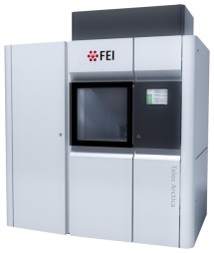 Model: Talos Arctica / Image courtesy: FEI Company |
 Movie
Movie Controller
Controller





















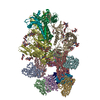
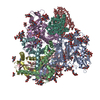
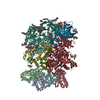
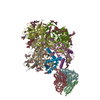

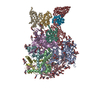
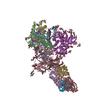
 Z (Sec.)
Z (Sec.) Y (Row.)
Y (Row.) X (Col.)
X (Col.)













































